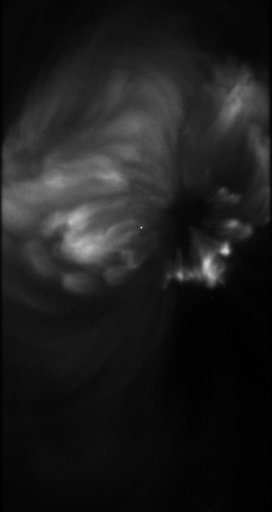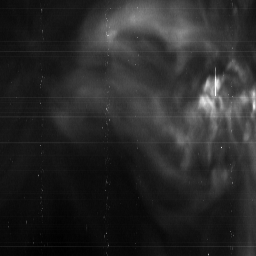|
EIS
Data Analysis Userguide The analysis guide covers
the basics of getting started with the data analysis. You can also find some
tips as knowledge progresses on the EIS wiki
/eiswiki/ which is our help desk. Quick
links: How do I get my
hands on the data? How do I read and
extract data? How do I do cosmic
ray removal? How do I calculate
velocities, line widths etc.? How do I identify
lines in the spectrum? How do I produce
slot movies from rastered data? How
do I get my hands on the data There are various means
to do this: The DARTS system at ISAS: http://darts.isas.jaxa.jp/hinode/top.do The ESA system in Norway: http://sdc.uio.no/search/API12.php The UK system at MSSL: /SolarB/ Each of these systems has
different ways of searching for data. The ESA one has thumbnails, the MSSL
system has a movie maker and thumbnails for both level 0 data (unprocessed)
and level 2 data (line shifts and line widths). Finally you can use the
eis_cat routine within IDL. This allows you to search for the data by
remotely searching the EIS catalogue. http://orpheus.nascom.nasa.gov/~zarro/idl/eis/eis.html There are 3 different
types of data files with EIS: Level 0: these are
reformatted data which are unprocessed. When you request data this is the
data you normally get. Level 1: We provide
software for you to obtain level 1 data - this is the calibrated data. The
routine is eis_prep. Level 2: Level 2 data
provides a quick look first cut at the velocities. Since this is an automated
process it is not recommended that you use this for detailed scientific work,
but merely as a quick-look to determine if there is anything interested in
the data sets such as large velocities. You can obtained the level 2 data and
have a look at it online. The level 2 data is produced only for 1" and
2" slit data. |
dark current subtraction
cosmic ray removal
flat field correction
hot pixels
absolute calibration
bad/missing pixels marked throughout
error saved in calibration object in eis_er_yymmdd_hhmmss.fits file
data contains pointer to calibration objects
object saved to file (level 1)
IDL>eis_prep,file,/def,/save
The EIS instrument is very flexible with many
different modes available - hence there are different ways of looking at the
data, some of which are described below. The main thing you need to consider is
which slit/slot was used - 1", 2", 40" and 266".
(a) Showing spectrum data
When using the 1" or 2" slit
rastering is often done. The dimension of raster scanning data is data[lambda, y, x]. If you do the following you can
have a quick look at a movie of the spectrum.
IDL> window,0,xs=xsize[ iwin ],ys=ysize[ iwin ]
IDL> stepper,data
(b) Display slot picture
In case of
the data was in the slot mode (i.e. 40" or 266"), then the following
will display the data. To show slot picture in correct direction, it is
necessary to reverse left-right (ie. east-west) direction.
IDL> window,0,xs=xsize[ iwin
],ys=ysize[ iwin ]
IDL> tvscl,rotate (data[ *, *, 0
], 5 )

(c) Displaying raster data
For raster
scanning data, integrating the spectrum along wavelength direction gives the
image of a particular spectral band.
IDL> intensity = rotate (total (data, 1), 1)
IDL> window,0,xs=nexp,ys=ysize[ iwin ]
IDL> tvscl,intensity

How do I do Cosmic Ray Removal
Cosmic ray removal is included within eis_prep, but
you may want to do this separately. There is a routine called
"eis_despike.pro" to do cosmic ray removal for one line window and on
exposure. So far there is now script available to process many line windows and
several exposures automatically. eis_despike is based on the SSW procedure
called "new_spike.pro", which has been extensively used and tested on
CDS data.
To do cosmic ray removal do:
SSWIDL> eis_despike, wd_in, wd_despike
INPUT:
wd_in: Linw window before CR removal
OUTPUT:
wd_despike: Line window after CR removal
KEYWORDS:
no_neighbours
no_fill
info
For description of keywords, see documentation of
new_spike.pro in SSW.
This is an example of how you concatenate files using
objects to create a movie.
We have dowloaded a number of files for
Feb 19, 2007 to an appropriate directory
[elstar:2007/02/19] viggoh% ls
eis_l0_2007*.gz
eis_l0_20070219_112228.fits.gz
eis_l0_20070219_140814.fits.gz eis_l0_20070219_150131.fits.gz
eis_l0_20070219_134135.fits.gz
eis_l0_20070219_143452.fits.gz eis_l0_20070219_193631.fits.gz
and we happen to know (we looked using
the SSW QL `xfilesÕ routine) that it is the files spanning 13:41 to 15:01 that
interest us. Before concatenation and analysis we will prep them to remove dark
current, cosmic rays, hot pixels and convert to physical intensity units as well
as calculate the measurement error. All of this is done by the SSW routine
eis_prep.
IDL> f0=file_search('eis_l0*.gz')
IDL> f0=f0[1:4]
IDL> print,f0
eis_l0_20070219_134135.fits.gz
eis_l0_20070219_140814.fits.gz eis_l0_20070219_143452.fits.gz
eis_l0_20070219_150131.fits.gz
IDL> for i=0,n_elements(f0)-1 do
begin eis_prep,f0[i],/def,/save
This is the default method of calling eis_prep; /def means
that default methods for cleaning up the data will be used, /save means that
the prepped data will be saved in an `eis_l1Õ fits file while the error
estimate will be saved in an `eis_erÕ fits file.
Concatenation
Observations are often spread over
several fits files, when analysing these it will often be advantageous to
concatenate. Here we will put all the slot observations of the Fe XII 195 line
into one cube.
IDL> f1=file_search('eis_l1*.fits')
IDL> f1=f1[1:4]
IDL> print,f1
eis_l1_20070219_134135.fits eis_l1_20070219_140814.fits
eis_l1_20070219_143452.fits eis_l1_20070219_150131.fits
IDL>
concat_cube,f1,4,cube,time_cube,line_id=line_id
% EIS_DATA::READFITS: old style format
fits file, no mhc temperatures
% EIS_DATA::READERR: Restoring errfile
"eis_er_20070219_134135.fits"
% EIS_DATA::READFITS: old style format
fits file, no mhc temperatures
% CONCAT_CUBE: Reading
eis_l1_20070219_134135.fits FE XII 195.120
% EIS_DATA::READFITS: old style format
fits file, no mhc temperatures
% EIS_DATA::READERR: Restoring errfile
"eis_er_20070219_140814.fits"
% EIS_DATA::READFITS: old style format
fits file, no mhc temperatures
% CONCAT_CUBE: Reading
eis_l1_20070219_140814.fits FE XII 195.120
% EIS_DATA::READFITS: old style format
fits file, no mhc temperatures
% EIS_DATA::READERR: Restoring errfile
"eis_er_20070219_143452.fits"
% EIS_DATA::READFITS: old style format
fits file, no mhc temperatures
% CONCAT_CUBE: Reading
eis_l1_20070219_143452.fits FE XII 195.120
% EIS_DATA::READFITS: old style format
fits file, no mhc temperatures
% EIS_DATA::READERR: Restoring errfile
"eis_er_20070219_150131.fits"
% EIS_DATA::READFITS: old style format
fits file, no mhc temperatures
% CONCAT_CUBE: Reading
eis_l1_20070219_150131.fits FE XII 195.120
IDL> help,cube
CUBE
FLOAT = Array[48, 512, 200]
IDL> print,time_cube
13:41:35 13:42:07 13:42:38 13:43:10
13:43:42 13:44:14 13:44:46 13:45:18 13:45:50 13:46:21 13:46:53 13:47:25
........
IDL> print,line_id
FE XII 195.120
The routine concat_cube is very simple
and uses a number of eis_data methods.
pro
concat_cube,f,iwin,cube,time_cube,line_id=line_id,err=err
if n_params() ne 4 then
begin
message,'concat_cube,f,iwin,cube,time_cube, line_id=line_id',/info
return
endif
for i=0,n_elements(f)-1 do
begin
data=obj_new('eis_data',f[i])
data->readerr
if i eq 0 then
line_id=(data->getline_id())[iwin]
message,'Reading
'+f[i]+' '+line_id,/info
wd=data->getvar(iwin)
er=data->geterr(iwin)
ti_1=(data->ti2tai(*(data->getaux_data()).ti_1))
time=anytim2utc(ti_1,/time_only,/ccsds,/truncate)
sz=size(wd)
nexp=data->getnexp()
if i eq 0 then begin
cube=fltarr(sz[1],sz[2],nexp*n_elements(f))
err=cube
time_cube=strarr(nexp*n_elements(f))
endif
cube[*,*,i*nexp:(i+1)*nexp-1]=wd
err[*,*,i*nexp:(i+1)*nexp-1]=er
time_cube[i*nexp:(i+1)*nexp-1]=time
obj_destroy,data
endfor
end